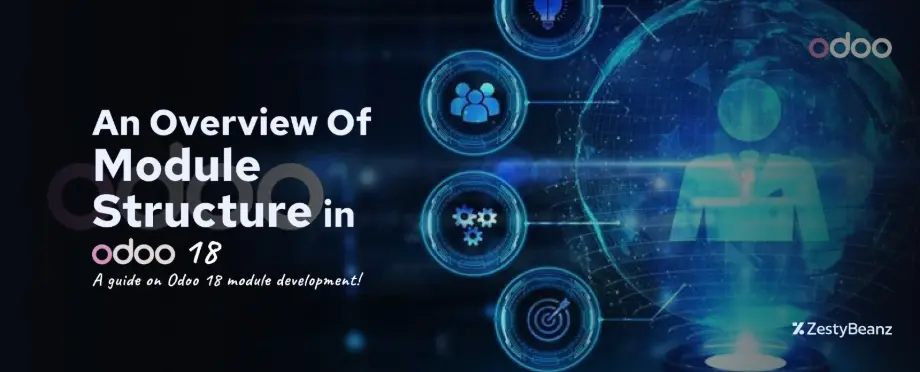
An Overview Of Module Structure in Odoo 18
Welcome to our guide on Odoo 18 module development! In this article, we'll explore how to create Odoo modules in a clear, structured way. Whether you're new to Odoo or looking to improve your skills, this guide will help you understand the essential concepts.
What is an Odoo Module?
An Odoo module is like a building block that adds new features to your Odoo system. Think of it as a package containing all the necessary files to add specific functionality to your business application. For example, you might create a module to manage:
Customer information
Product inventory
Sales orders
- Employee records
__init__.py
This file is used to import Python files like models, controllers, or wizards within the module. Without it, Python won't recognize the directory as a module.
from . import modelsfrom . import controllers |
__manifest__.py
The manifest file tells Odoo what your module is and how to use it. Think of it as your module's ID card that contains important details like:
What it's called
Which version it is
What it does
What features it needs to work
Here's an example of a manifest file:
{'name': 'Module Name','version': '1.0','summary': """Summary of the Module""",'description': """Description of the Module""",'category': 'product','author': '','company': 'Zesty Beanz Technologies','maintainer': 'Zesty Beanz Technologies','website': 'https://www.zbeanztech.com/','depends': ['base'],'data': ['security/ir.model.access.csv','data/filename.xml','views/filename.xml',],'assets': {'web.assets_backend': ['module_name/static/src/js/*.js','module_name/static/src/css/*.css','module_name/static/src/img/*',],},'images': [],'license': 'AGPL-3','installable': True,'auto_install': False,'application': False,} |
Here's a simplified and structured breakdown of the parameters:
name: The module's name.
version: The version number of the module.
summary: A short, one-line description of the module's purpose.
description: A detailed explanation of what the module does.
category: The classification or type of the module.
author: The creator's name.
company: The company associated with the module.
maintainer: The person or team responsible for keeping the module up to date.
website: The module's or maintainer's website URL.
depends: A list of other modules this module needs to work.
data: Files (XML/CSV) to be loaded when installing or updating the module, like views and security configurations.
assets: CSS, JavaScript, images, and other resources used by the module.
images: Paths to images linked to the module.
license: The type of license the module uses.
installable: A boolean value indicating if the module can be installed.
application: A boolean value defining if the module works as a standalone app.
auto_install: A boolean that determines if the module installs automatically when dependencies are met.
Key Components of an Odoo Module
An Odoo module consists of several essential components that define its structure and functionality:
Models
Python classes that implement the business logic and define the data models for the module.
Views
XML files that specify the user interface elements, such as forms, lists, and dashboards.
Security
Configurations for user permissions, record rules, and user groups.
Example: ir.model.access.csv for defining access control rules.
Data
XML or CSV files used to initialize or preload data, such as default settings or demonstration records.
Static
Contains static assets like images, JavaScript, CSS, and other media used by the module.
Wizard
Python and XML files for creating interactive wizard forms, often used for batch processing or custom workflows.
Controller
Python files that define HTTP controllers to handle web requests.
Reports
Templates and configurations required for generating custom reports.
i18n
Translation files for supporting multiple languages, such as en.po or fr.pot.
Conclusion
Understanding the structure of Odoo modules is crucial for creating, customizing, and maintaining effective applications within the platform.
By organizing module components properly and following best practices, developers can build scalable, reliable, and easy-to-maintain modules that integrate seamlessly with Odoo. Whether developing a new module or enhancing an existing one, a solid grasp of the module structure ensures smooth and successful implementation.
If you are looking for an ERP implementation partner with diverse industry experience feel free to contact us. Zesty Beanz Technologies is headquartered in Trivandrum Kerala, We have proven track record of successful implementations across the world in various sectors including Odoo for Manufacturing, Odoo for Trading, Odoo for FMCG, Odoo for Oil & Gas, Odoo for Diary, Odoo for Pharma, Odoo for Cosmetic Clinic, Odoo for Contracting Companies, Odoo for HVAC, Odoo for Logistics, Odoo for Automobile, Odoo for Laundry, Odoo for Field Service, Odoo for E-Commerce & many more
ZestyBeanz offers Developer / Consultant outsourcing programs, Chat with us in Whatsapp and Hire Odoo Developers, Mobile Application Developers, Consultants.
#OdooDevelopment #Odoo18 #OdooTips #Odoofeatures #ERPSolutions #OpenSourceERP #BusinessTechnology #SoftwareDevelopment






























